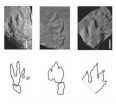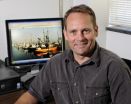(Press-News.org) New neuroscience research by life scientists from UCLA and Australia may potentially help people who have lost their ability to remember due to brain injury or disease.
By examining how we learn and store memories, these scientists have shown that the way the brain first captures and encodes a situation or event is quite different from how it processes subsequent similar events.
The study is published in the Sept. 29 edition of the online journal PLoS ONE, a publication of the Public Library of Science.
Memories are formed in the part of the brain known as the hippocampus, a seahorse-shaped structure that plays critical roles in processing, storing and recalling information. The hippocampus is very susceptible to damage through stroke or lack of oxygen and is critically involved in Alzheimer's disease, said study co-author Michael Fanselow, a UCLA professor of psychology and a member of the UCLA Brain Research Institute.
When a memory is first formed, a small protein involved in synaptic transmission — the NMDA receptor — is indispensable to the process, said study co-author Bryce Vissel, a group leader of the neuroscience research program at Sydney's Garvan Institute of Medical Research. Activation of the NMDA receptor allows calcium to enter a neuron, and calcium permeability enables a chain of molecular reactions that help encode experience and consolidate memory, Fanselow and Vissel said.
Learning theorists have assumed that learning cannot occur without NMDA receptors. But the new findings show that NMDA receptors are not essential in "second-learning," when the rules of "first-learning" are applied to new yet similar scenarios. Instead, another class of receptors known as AMPA receptors, also calcium permeable, appears to take up the task.
Although the findings are still preliminary, Fanselow is optimistic about what it could mean for people whose memory formation has been impaired.
"The system we are working with is one that we know is critically involved in Alzheimer's disease and other kinds of brain deficit memory impairment," he said. "This is just the start. We have uncovered a mechanism that contributes to learning and memory, and we now have to figure out what to do with it. When is it important normally? When can we harness it to take over function when the normal mechanisms aren't working? Can we use it to have some protective effect in conditions like Alzheimer's disease, where neurons are dying? Can we stimulate these pathways and keep them participating in memories?
"We can see that we might now have a target for drugs that are different from the standard class of cognitive enhancers," he added. "We can see the possibilities for different styles of training that better activate this newly discovered mechanism."
If the processes involved in second-stage learning can be mimicked therapeutically, he said, the health benefits potentially could be substantial.
Fanselow and Vissel have worked closely over the last six years, along with Thomas O'Dell, a UCLA professor of physiology at the David Geffen School of Medicine at UCLA, to unravel the two different synaptic mechanisms and their meanings.
"When we started this research, we knew that the NMDA receptor was implicated in learning and memory, and we decided to see if we could mimic its process through another receptor system," said Vissel, a molecular neuroscientist. "Instead of having to create a new receptor system, we discovered one already in existence — one that was NMDA-independent. This amounted to uncovering a whole new mechanism of learning."
###
Co-authors on the research are Stephen Heinemann (Salk Institute)' Susumu Tonegawa (Massachusetts Institute of Technology); Brian Wiltgen (University of Virginia); Gordon Royle, Andrea Abdipranoto, and Nopporn Thangthaeng (Garvan Institute); and Erin Gray, Nate Jacobs and Faysal Saab (UCLA).
For more information about Fanselow's research, visit http://fanselowlab.psych.ucla.edu/Main/Home.html.
For more on the Garvan Institute of Medical Research, visit www.garvan.org.au.
The research was federally funded by the National Institute of Mental Health and the National Science Foundation.
UCLA is California's largest university, with an enrollment of more than 38,000 undergraduate and graduate students. The UCLA College of Letters and Science and the university's 11 professional schools feature renowned faculty and offer 328 degree programs and majors. UCLA is a national and international leader in the breadth and quality of its academic, research, health care, cultural, continuing education and athletic programs. Five alumni and five faculty have been awarded the Nobel Prize.
For more news, visit the UCLA Newsroom and follow us on Twitter.
END
The following highlights summarize research papers that have been recently published in Geophysical Research Letters (GRL), Journal of Geophysical Research-Atmospheres (JGR-D), or Water Resources Research (WRR).
1. Antarctic sea ice increase not linked to ozone hole
While sea ice extent has declined dramatically in the Arctic in recent years, it has increased slightly in the Antarctic. Some scientists have suggested that increased Antarctic sea ice extent can be explained by the ozone hole over Antarctica. Previous simulations have indicated that the ozone hole induces ...
The oldest evidence of the dinosaur lineage—fossilized tracks—is described this week in Proceedings of the Royal Society B. Just one or two million years after the massive Permian-Triassic extinction, an animal smaller than a house cat walked across fine mud in what is now Poland. This fossilized trackway places the very closest relatives of dinosaurs on Earth about 250 million years ago—5 to 9 million years earlier than previously described fossilized skeletal material has indicated. The paper also described the 246-million-year-old Sphingopus footprints, the oldest evidence ...
CHAMPAIGN, Ill. – When the economy sours, small firms seeking credit tend to face higher costs of financing, leading them to reinvest their profits before they pay off creditors, according to research published by a University of Illinois finance expert.
Small firms, especially those considered financially constrained as a result of their size, low dividend payment or lack of bond rating, often become bogged down in debt because they "get hooked on cheap money, when they can find it" says U. of I. finance professor Murillo Campello.
"Since small firms are usually financially ...
AMES, Iowa - Some fisheries in the United States are poised to undergo major changes in the regulations used to protect fish stocks, and Iowa State University researchers have estimated that the new system will be an economic boon to the fishing industry.
Quinn Weninger and Rajesh Singh, both associate professors in economics, estimated harvesting costs under the old system and compared that to the newly proposed fishing regulations that lift many restrictions that cause inefficiency while still limiting amounts to be harvested.
Their analysis focused on the Pacific Groundfish ...
The pace and extent of Marcellus Shale development across Pennsylvania can be "seen" in animated maps produced by the Penn State Marcellus Center for Outreach and Research.
Based on data from the Pennsylvania Department of Environmental Protection, the animations (http://www.marcellus.psu.edu/resources/maps.php) show both the number of drilling permits issued for the Marcellus Shale target and the number of wells drilled by year from 2007 through August 2010. Although permits were issued prior to 2007, information on those permits did not include latitude and longitude.
"These ...
Sensation seeking—the urge to do exciting things—has been linked to dopamine, a chemical that carries messages in your brain. For a new study published in Psychological Science, a journal of the Association for Psychological Science, scientists analyzed genes in the dopamine system and found a group of mutations that help predict whether someone is inclined toward sensation seeking.
Sensation seeking has been linked to a range of behavior disorders, such as drug addiction. It isn't all bad, though. "Not everyone who's high on sensation seeking becomes a drug addict. They ...
DURHAM, N.H. -- Looking at a hagfish – an eyeless, snot-covered, worm-like scavenger of the deep –the last thing that comes to mind is sex. Yet the reproductive functioning of these ancient vertebrates is such an enduring enigma that a gold medal was once offered to anyone who could elucidate it.
Although the prize expired, unclaimed, long ago, University of New Hampshire professor of biochemistry Stacia Sower and colleagues at two Japanese universities have identified the first reproductive hormone of the hagfish – a gonadatropin -- representing a significant step toward ...
Researchers from Northwestern University and NorthShore University HealthSystem (NorthShore) have developed a method to detect early signs of lung cancer by examining cheek cells in humans using pioneering biophotonics technology.
"By examining the lining of the cheek with this optical technology, we have the potential to prescreen patients at high risk for lung cancer, such as those who smoke, and identify the individuals who would likely benefit from more invasive and expensive tests versus those who don't need additional tests," said Hemant K. Roy, M.D., director ...
Berkeley – Exposure to dirty air is linked to decreased function of a gene that appears to increase the severity of asthma in children, according to a joint study by researchers at Stanford University and the University of California, Berkeley.
While air pollution is known to be a source of immediate inflammation, this new study provides one of the first pieces of direct evidence that explains how some ambient air pollutants could have long-term effects.
The findings, published in the October 2010 issue of the Journal of Allergy and Clinical Immunology, come from ...
WEST LAFAYETTE, Ind. - Doppler weather radar will significantly improve forecasting models used to track monsoon systems influencing the monsoon in and around India, according to a research collaboration including Purdue University, the National Center for Atmospheric Research and the Indian Institute of Technology Delhi.
Dev Niyogi, a Purdue associate professor of agronomy and earth and atmospheric sciences, said modeling of a monsoon depression track can have a margin of error of about 200 kilometers for landfall, which can be significant for storms that produce as ...


